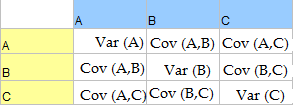
Variables can fail to be homoscedastic for two main reasons:
- One variable may be non-normal,
- One variable may have a relationship to the transformation of another variable.
Testing for Homogeneity of Covariance Matrices
Box’s Test, which uses the F Distribution, is one way to test for homogeneity of covariance matrices. If the p-value is less than .05, then the covariances are significantly different, which means the assumption is violated. therefore, this is one test where you do not want a significant result. In other words, the p-value should be greater than .05 to show that the assumption is upheld.
Another possibility is to test variables for normality; if one variable isn’t normally distributed then the assumption of homoscedasticity will certainly not be met. Testing for normality becomes very important when using Box’s M, as the test is very sensitive from departures from normality [2].
Failure to meet the assumption for homogeneity of covariance matrices does not always mean you can’t run a statistical analysis. For example, In MANOVA, unequal n’s appear as sample sizes decrease, violating the assumption of homogeneity of covariance. In this case, use Pillai’s trace as it is more robust than other tests statistics like Hotelling’s trace, Roy’s largest root, or Wilks’ Lambda. [3].
References
[1] Mertler & Vannatta (2005). Advanced and Multivariate Statistical Methods (3rd Edition). Routledge.
[2] Overview (MANOVA).Retreived November 24, 2021 from: http://faculty.chass.ncsu.edu/garson/PA765/manova.htm
[3] Hasan, N. (2020). MANOVA/MANCOVA using SPSS.